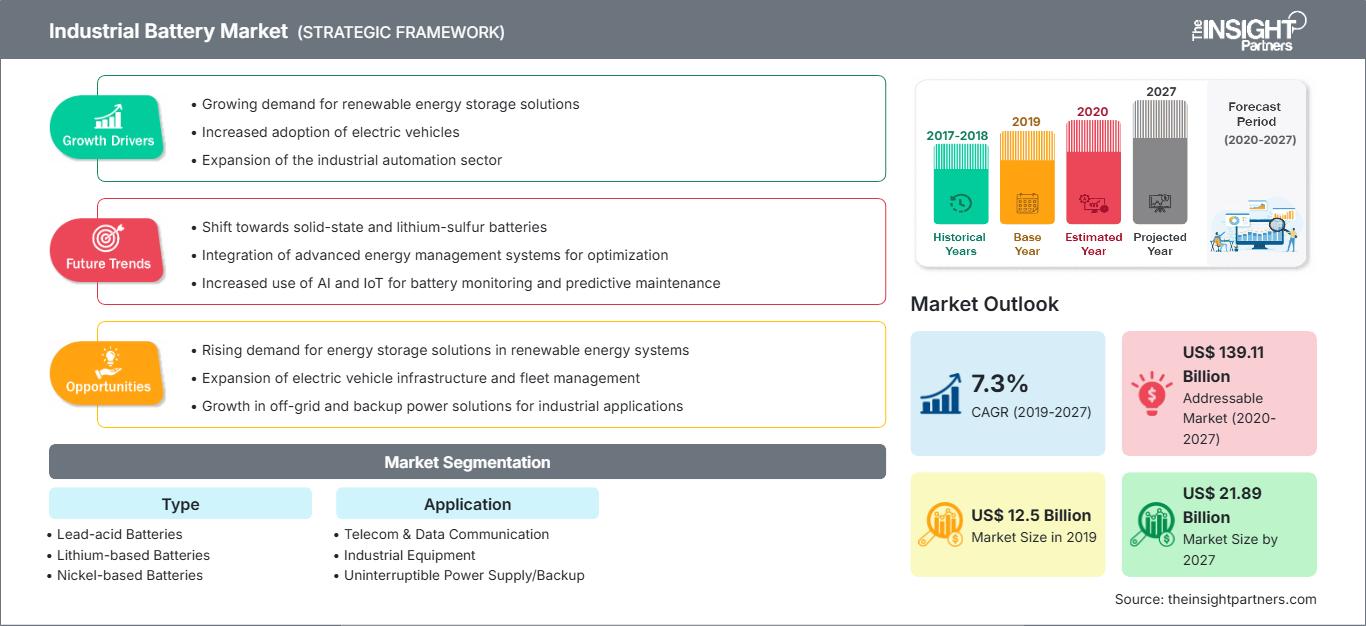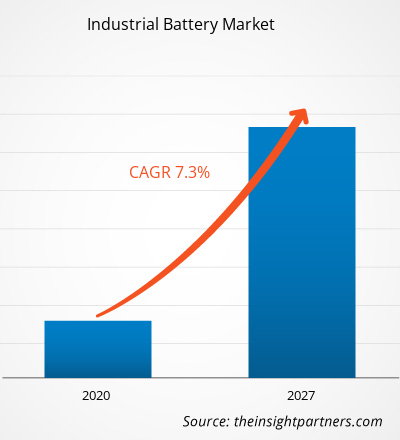Il mercato delle batterie industriali è stato valutato a 12.501,9 milioni di dollari nel 2019 e si prevede che crescerà a un CAGR del 7,3% dal 2020 al 2027, raggiungendo i 21.893,5 milioni di dollari entro il 2027.
Le batterie industriali sono batterie appositamente progettate per funzionare a temperature industriali estreme, come temperature estreme, vibrazioni elevate e uso intensivo. Le batterie industriali offrono prestazioni migliori e sono progettate per essere più potenti. Nell'attuale scenario di mercato, le aziende stanno lavorando con impegno allo sviluppo di batterie ad alta efficienza che soddisfino le diverse esigenze delle batterie industriali. Si prevede che il mercato globale delle batterie industriali registrerà una crescita impressionante durante il periodo di previsione. Si prevede che la domanda di batterie al litio crescerà significativamente durante il periodo di previsione. Si prevede che l'adozione delle batterie al litio crescerà in diversi settori verticali grazie ai vantaggi offerti, come basse emissioni, maggiore ciclo di vita e riciclabilità. Le aziende che operano sul mercato si stanno concentrando sullo sviluppo di nuovi prodotti per acquisire una solida base di clienti e raggiungere una quota di mercato significativa.
Il governo dei paesi nordamericani, come gli Stati Uniti, sta adottando misure continue per migliorare la produttività dell'industria manifatturiera, ad esempio fornendo le tecnologie più recenti per semplificare il processo di produzione e aumentare il numero di magazzini. Si prevede che l'uso di tecnologie automatizzate in questi magazzini influenzerà la crescita del mercato delle batterie industriali in Nord America. L'aumento della spesa pubblica favorisce lo sviluppo di qualsiasi tecnologia. Nella regione nordamericana, la spesa pubblica per attività di avanzamento tecnologico è piuttosto elevata, il che crea un clima favorevole allo sviluppo di qualsiasi attività commerciale. IoT, Big Data e tecnologie avanzate hanno registrato un'elevata adozione in questa regione. Queste tecnologie, a loro volta, alimentano i requisiti di una rete potenziata e la domanda di batterie industriali. Alcune tecnologie emergenti nel mercato delle batterie industriali sono le batterie agli ioni di litio (Li-ion) di nuova generazione, le batterie al litio-zolfo, le batterie allo stato solido, le batterie agli ioni di alluminio, ecc.
Personalizza questo rapporto in base alle tue esigenze
Potrai personalizzare gratuitamente qualsiasi rapporto, comprese parti di questo rapporto, o analisi a livello di paese, pacchetto dati Excel, oltre a usufruire di grandi offerte e sconti per start-up e università
Mercato delle batterie industriali: Approfondimenti strategici

- Ottieni le principali tendenze chiave del mercato di questo rapporto.Questo campione GRATUITO includerà l'analisi dei dati, che vanno dalle tendenze di mercato alle stime e alle previsioni.
Approfondimenti di mercato: le soluzioni connesse alla rete per l'alimentazione ininterrotta stimolano la domanda di batterie industriali. Le fonti di energia rinnovabile più importanti ed essenziali sono il sole e il vento, che vengono accumulati nella rete. Tuttavia, la copertura del sole da parte delle nuvole o le fluttuazioni della corrente del vento possono portare a variazioni nel processo di generazione di energia. Tali cambiamenti creano la necessità di sistemi di rete flessibili per l'accumulo di energia. I sistemi di accumulo di energia a batteria industriali aiutano i gestori di rete a risparmiare elettricità quando la quantità di energia supera la domanda di elettricità. Pertanto, la crescente adozione di questi sistemi contribuisce a migliorare l'affidabilità e la flessibilità del sistema di fornitura elettrica per quanto riguarda le attività di generazione, trasmissione e distribuzione. Durante la trasmissione e la distribuzione, i sistemi di accumulo di energia a batteria gestiscono vari aspetti come il differimento delle risorse, la soppressione delle armoniche, il supporto della tensione, la regolazione della frequenza e la qualità dell'energia. Altri vantaggi dell'utilizzo di sistemi di accumulo di energia a batteria per soluzioni connesse alla rete sono lo spostamento temporale dell'energia elettrica, lo spostamento temporale delle energie rinnovabili, il livellamento del carico di base, il peak shaving e il consolidamento della capacità delle fonti rinnovabili, che ne guidano l'adozione e alimentano la crescita del mercato delle batterie industriali. Gli operatori del mercato stanno sviluppando nuove soluzioni di rete per mantenere un vantaggio competitivo nel mercato delle batterie industriali. Ad esempio, Siemens offre SIESTORAGE, una soluzione di rete intelligente. SIESTORAGE è in grado di superare le sfide che si presentano nei tre aspetti principali dell'approvvigionamento energetico: ottimizzare le connessioni alla rete, fornire energia elastica per le reti moderne e supportare i grandi consumatori di energia. Inoltre, nel luglio 2015, EDP Distribuicao ha offerto a SIESTORAGE di Siemens a Evora (Portogallo) la gara per Storage InovGrid. Il sistema SIESTORAGE fornisce servizi come la regolazione della tensione, il backup energetico e il peak shaving per la stabilità della rete di EDP, replicando i vantaggi delle reti intelligenti per gli operatori di rete. Approfondimenti sulle tipologie
Potrai personalizzare gratuitamente qualsiasi rapporto, comprese parti di questo rapporto, o analisi a livello di paese, pacchetto dati Excel, oltre a usufruire di grandi offerte e sconti per start-up e università
Mercato delle batterie industriali: Approfondimenti strategici

- Ottieni le principali tendenze chiave del mercato di questo rapporto.Questo campione GRATUITO includerà l'analisi dei dati, che vanno dalle tendenze di mercato alle stime e alle previsioni.
Nel segmento delle tipologie, le batterie al piombo-acido hanno conquistato la quota maggiore del mercato globale delle batterie industriali. Le batterie al piombo-acido sono economiche e offrono prestazioni elevate, sono facilmente riciclabili e semplici da ricaricare. L'impiego delle batterie al piombo-acido è ampio grazie al loro basso costo e alla lunga durata. Tuttavia, la batteria non è adatta a carichi elevati e prolungati; inoltre, ha una densità di energia volumetrica relativamente bassa, il che rende il loro impiego leggermente impraticabile per applicazioni di gestione energetica; pertanto, viene utilizzata principalmente per applicazioni di potenza. I progressi di questa batteria sono ancora in corso, il che potrebbe consentirle di diventare un'opzione più praticabile per la gestione energetica.
Approfondimenti sulle applicazioni
Il mercato delle batterie industriali, per applicazione, è segmentato in telecomunicazioni e comunicazione dati, apparecchiature industriali, gruppi di continuità (UPS)/backup, minerario, navale e altri. Il segmento delle apparecchiature industriali ha conquistato una quota dominante nel mercato globale delle batterie industriali. Le crescenti tendenze dell'Industria 4.0, come IoT, Intelligenza Artificiale (IA), analisi dei big data, comunicazioni in rete, cloud computing e tecnologie di apprendimento automatico, segnano un cambiamento sostanziale nel modo in cui le aziende lavorano e interagiscono con i propri clienti. Queste tecnologie in crescita offrono soluzioni innovative per apparecchiature industriali che supportano la produzione e la consegna di apparecchiature efficienti.
La strategia di fusione e acquisizione è comunemente adottata dalle aziende per espandere la propria presenza a livello mondiale e soddisfare la crescente domanda. Questa strategia è osservata principalmente in Nord America e in Europa. Gli operatori presenti nel mercato delle batterie industriali adottano una strategia di espansione e investimenti in ricerca e sviluppo per ampliare la base clienti in tutto il mondo, il che consente loro anche di mantenere il proprio marchio a livello globale. Di seguito sono elencate alcune delle recenti acquisizioni;
2019: East Penn ha annunciato l'acquisizione della maggioranza di Navitas Systems. Si prevede che questa acquisizione supporterà l'espansione dell'offerta di batterie per trazione. 2019: Saft ha annunciato l'acquisizione del 100% delle azioni di Go Electric Inc., uno sviluppatore statunitense di soluzioni di resilienza energetica distribuita per microreti e clienti commerciali e industriali.
Mercato delle batterie industriali
Le tendenze regionali e i fattori che influenzano il mercato delle batterie industriali durante il periodo di previsione sono stati ampiamente spiegati dagli analisti di The Insight Partners. Questa sezione illustra anche i segmenti e la geografia del mercato delle batterie industriali in Nord America, Europa, Asia-Pacifico, Medio Oriente e Africa, America meridionale e centrale.
Ambito del rapporto sul mercato delle batterie industriali
| Attributo del rapporto | Dettagli |
|---|---|
| Dimensioni del mercato in 2019 | US$ 12.5 Billion |
| Dimensioni del mercato per 2027 | US$ 21.89 Billion |
| CAGR globale (2019 - 2027) | 7.3% |
| Dati storici | 2017-2018 |
| Periodo di previsione | 2020-2027 |
| Segmenti coperti |
By Tipo
|
| Regioni e paesi coperti | Nord America
|
| Leader di mercato e profili aziendali chiave |
|
Densità degli operatori del mercato delle batterie industriali: comprendere il suo impatto sulle dinamiche aziendali
Il mercato delle batterie industriali è in rapida crescita, trainato dalla crescente domanda degli utenti finali, dovuta a fattori quali l'evoluzione delle preferenze dei consumatori, i progressi tecnologici e una maggiore consapevolezza dei vantaggi del prodotto. Con l'aumento della domanda, le aziende stanno ampliando la propria offerta, innovando per soddisfare le esigenze dei consumatori e sfruttando le tendenze emergenti, alimentando ulteriormente la crescita del mercato.

- Ottieni il Mercato delle batterie industriali Panoramica dei principali attori chiave
- Batterie al piombo
- Batterie al litio
- Batterie al nichel
- Altro
Mercato delle batterie industriali: per applicazione
- Telecomunicazioni e Comunicazione dati
- Apparecchiature industriali
- UPS/Backup
- Accumulo di energia a livello di rete
- Settore minerario
- Settore marittimo
- Altro
Mercato globale delle batterie industriali per regione
Nord America
- Stati Uniti
- Canada
- Messico
Europa
- Francia
- Germania
- Italia
- Regno Unito
- Russia
- Resto d'Europa
Asia Pacifico
- Cina
- India
- Corea del Sud
- Giappone
- Australia
- Resto dell'Asia Pacifico
Medio Africa orientale
- Sudafrica
- Arabia Saudita
- Emirati Arabi Uniti
- Resto del Medio Oriente e Africa
Sud America
- Brasile
- Argentina
- Resto del Sud America
Profili aziendali
- C&D Technologies, Inc.
- East Penn Manufacturing Company
- EnerSys
- Exide Industries Limited
- General Electric Company
- GS Yuasa International Ltd.
- LG Chem
- Panasonic Corporation
- Robert Bosch GmbH
- Saft Groupe SA
- Analisi storica (2 anni), anno base, previsione (7 anni) con CAGR
- Analisi PEST e SWOT
- Valore/volume delle dimensioni del mercato - Globale, Regionale, Nazionale
- Industria e panorama competitivo
- Set di dati Excel
Report recenti
Rapporti correlati
Testimonianze
Motivo dell'acquisto
- Processo decisionale informato
- Comprensione delle dinamiche di mercato
- Analisi competitiva
- Analisi dei clienti
- Previsioni di mercato
- Mitigazione del rischio
- Pianificazione strategica
- Giustificazione degli investimenti
- Identificazione dei mercati emergenti
- Miglioramento delle strategie di marketing
- Aumento dell'efficienza operativa
- Allineamento alle tendenze normative




















 Ottieni un campione gratuito per - Mercato delle batterie industriali
Ottieni un campione gratuito per - Mercato delle batterie industriali